Implementation of Boolean Logic Operations and Refresh Circuit for 2T DRAM-Based PIM Architecture
Abstract
1. Introduction
2. 2T DRAM Investigation
3. 2T DRAM Cell Simulation Results
4. 2T DRAM Array with Boolean Operation
4.1. Fundamental Boolean Operation
4.2. XOR Boolean Operation Circuit
5. Refresh Circuit for Multi-Bit
6. Conclusions
Author Contributions
Funding
Data Availability Statement
Conflicts of Interest
References
- McKee, S.A. Reflections on the memory wall. In Proceedings of the 1st Conference on Computing Frontiers, Ischia, Italy, 14–16 April 2004. [Google Scholar]
- Gholami, A.; Yao, Z.; Kim, S.; Hooper, C.; Mahoney, M.W.; Keutzer, K. Ai and memory wall. IEEE Micro 2024, 44, 33–39. [Google Scholar] [CrossRef]
- Mudigonda, J.; Vin, H.M.; Yavatkar, R. Overcoming the memory wall in packet processing: Hammers or ladders? In Proceedings of the 2005 ACM Symposium on Architecture for Networking and Communications Systems, Princeton, NJ, USA, 26–28 October 2005. [Google Scholar]
- Zou, X.; Xu, S.; Chen, X.; Yan, L.; Han, Y. Breaking the von Neumann bottleneck: Architecture-level processing-in-memory technology. Sci. China Inf. Sci. 2021, 64, 160404. [Google Scholar] [CrossRef]
- Saulsbury, A.; Pong, F.; Nowatzyk, A. Missing the memory wall: The case for processor/memory integration. ACM SIGARCH Comput. Archit. News 1996, 24, 90–101. [Google Scholar] [CrossRef]
- Huang, X.; Liu, C.; Jiang, Y.-G.; Zhou, P. In-memory computing to break the memory wall*. Chin. Phys. B 2020, 29, 078504. [Google Scholar] [CrossRef]
- Masadeh, M.; Hasan, O.; Tahar, S. Input-conscious approximate multiply-accumulate (MAC) unit for energy-efficiency. IEEE Access 2019, 7, 147129–147142. [Google Scholar] [CrossRef]
- Tang, S.-N.; Han, Y.-S. A High-accuracy hardware-efficient multiply–accumulate (mac) unit based on dual-mode truncation error compensation for cnns. IEEE Access 2020, 8, 214716–214731. [Google Scholar] [CrossRef]
- Nguyen, V.T.; Kim, J.-S.; Lee, J.-W. 10T SRAM computing-in-memory macros for binary and multibit MAC operation of DNN edge processors. IEEE Access 2021, 9, 71262–71276. [Google Scholar] [CrossRef]
- Yu, K.; Kim, S.; Choi, J.R. Trends and Challenges in Computing-in-Memory for Neural Network Model: A Review From Device Design to Application-Side Optimization. IEEE Access 2024, 12, 186679–186702. [Google Scholar] [CrossRef]
- Chung, K.-Y.; Kim, H.; An, Y.; Seong, K.; Shin, D.-H.; Baek, K.-H.; Shim, Y. 8T-SRAM based process-in-memory (pim) system with current mirror for accurate mac operation. IEEE Access 2024, 12, 24254–24261. [Google Scholar] [CrossRef]
- Cho, Y.; Kim, Y.-S.; Kwon, M.-W. Mitigating Pass Gate Effect in Buried Channel Array Transistors Through Buried Oxide Integration: Addressing Interference Phenomenon Between Word Lines. Appl. Sci. 2024, 14, 10348. [Google Scholar] [CrossRef]
- Kim, Y.-S.; Lim, C.-Y.; Kwon, M.-W. Mitigating WL-to-WL disturbance in dynamic random-access memory (DRAM) through adopted spherical shallow trench isolation with silicon nitride layer in the buried channel array transistor (BCAT). Electronics 2024, 13, 681. [Google Scholar] [CrossRef]
- Kim, Y.-S.; Kwon, M.-W. Mitigation of 1-Row Hammer in BCAT Structures Through Buried Oxide Integration and Investigation of Inter-Cell Disturbances. Electronics 2024, 13, 4936. [Google Scholar] [CrossRef]
- Kim, G.-B.; Nam, C.-H.; Kim, Y.-S.; Park, J.-H.; Kwon, J.; Baek, M.-H. Suppression of Interference Characteristics in 3D Vertical DRAM. J. Semicond. Technol. Sci. 2025, 25, 134–141. [Google Scholar] [CrossRef]
- Li, Q.; Hu, Q.; Zhu, S.; Zeng, M.; Zhao, W.; Wu, Y. 3D stacked IGZO 2T0C DRAM array with multibit capability for computing in memory applications. Sci. Adv. 2025, 11, eadu4323. [Google Scholar] [CrossRef] [PubMed]
- Zhu, Z.Y.; Kang, B.M.; Dan, W.; Wu, X.S.; Son, J.; Yu, Y.; Xiao, D.-Y.; Dai, J.; Wang, G.-L.; Yoo, A.; et al. Novel 2T DRAM by Storing Data in One Alternative Gate of a Double-Gate Transistor with a Low-leakage Oxide Transistor. In Proceedings of the 2022 IEEE 16th International Conference on Solid-State & Integrated Circuit Technology (ICSICT), Nanjing, China, 25–28 October 2022; IEEE: Piscataway, NJ, USA, 2022. [Google Scholar]
- Zhao, Y.; Shen, Z.; Xu, J.; Chai, K.C.; Wu, Y.; Wang, C. A novel transpose 2T-DRAM based computing-in-memory architecture for on-chip DNN training and inference. In Proceedings of the 2023 IEEE 5th International Conference on Artificial Intelligence Circuits and Systems (AICAS), Hangzhou, China, 11–13 June 2023; IEEE: Piscataway, NJ, USA, 2023. [Google Scholar]
- Ansari, H.R.; Singh, J. Capacitorless 2T-DRAM for higher retention time and sense margin. IEEE Trans. Electron. Devices 2020, 67, 902–906. [Google Scholar] [CrossRef]
- Belmonte, A.; Oh, H.; Rassoul, N.; Donadio, G.L.; Mitard, J.; Dekkers, H.; Delhougne, R.; Subhechha, S.; Chasin, A.; van Setten, M.J.; et al. Capacitor-less, long-retention (>400 s) DRAM cell paving the way towards low-power and high-density monolithic 3D DRAM. In Proceedings of the 2020 IEEE International Electron Devices Meeting (IEDM), San Francisco, CA, USA, 12–18 December 2020; IEEE: Piscataway, NJ, USA, 2020. [Google Scholar]
- Oh, H.; Belmonte, A.; Perumkunnil, M.; Mitard, J.; Rassoul, N.; Donadio, G.L.; Delhougne, R.; Furnemont, A.; Kar, G.S.; Dehaene, W. Enhanced data integrity of In-Ga-Zn-oxide based capacitor-less 2T memory for DRAM applications. In Proceedings of the ESSDERC 2021-IEEE 51st European Solid-State Device Research Conference (ESSDERC), Grenoble, France, 13–22 September 2021; IEEE: Piscataway, NJ, USA, 2021. [Google Scholar]
- Lu, W.; Chen, K.; Liu, M.; Liao, F.; Wu, Z.; Mao, N.; Li, Z.; Zhang, X.; Lu, C.; Niu, J.; et al. IGZO 2T1C DRAM with Low Operation Voltage and High Current Window. IEEE J. Electron. Devices Soc. 2025, 13, 444–449. [Google Scholar] [CrossRef]
- Seshadri, V.; Lee, D.; Mullins, T.; Hassan, H.; Boroumand, A.; Kim, J.; Kozuch, M.A.; Mutlu, O.; Gibbons, P.B.; Mowry, T.C. Ambit: In-memory accelerator for bulk bitwise operations using commodity DRAM technology. In Proceedings of the 50th Annual IEEE/ACM International Symposium on Microarchitecture, Cambridge, MA, USA, 14–18 October 2017. [Google Scholar]
- Gao, C.; Xin, X.; Lu, Y.; Zhang, Y.; Yang, J.; Shu, J. Parabit: Processing parallel bitwise operations in nand flash memory based SSDs. In Proceedings of the MICRO-54: 54th Annual IEEE/ACM International Symposium on Microarchitecture, Virtual Event, 18–22 October 2021. [Google Scholar]
- Kvatinsky, S.; Belousov, D.; Liman, S.; Satat, G.; Wald, N.; Friedman, E.G.; Kolodny, A.; Weiser, U.C. MAGIC—Memristor-aided logic. IEEE Trans. Circuits Syst. II Express Briefs 2014, 61, 895–899. [Google Scholar] [CrossRef]
- Mattar, J.; Dahan, M.M.; Dunkel, S.; Mulaosmanovic, H.; Beyer, S.; Yalon, E.; Wainstein, N. Reconfigurable Time-Domain In-Memory Computing Marco using CAM FeFET with Multilevel Delay Calibration in 28 nm CMOS. arXiv 2025, arXiv:2504.03925. [Google Scholar]

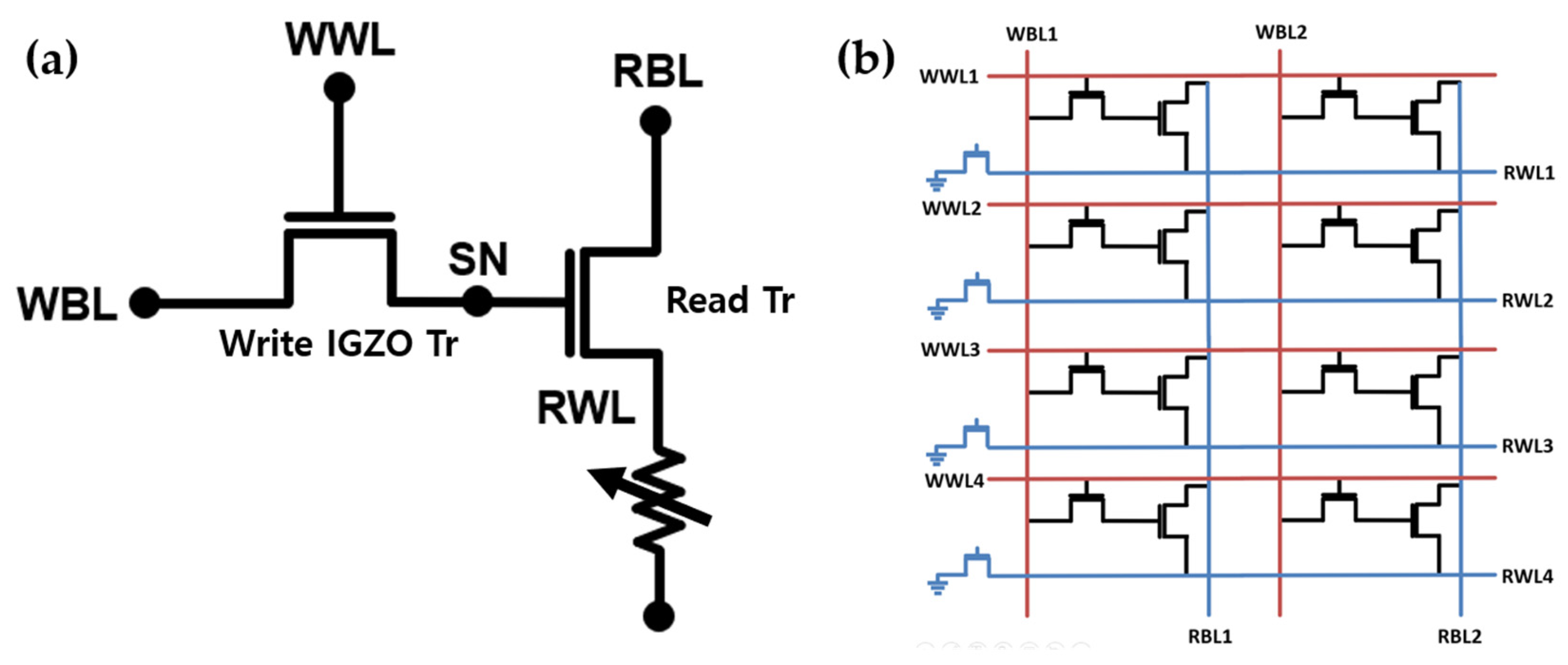
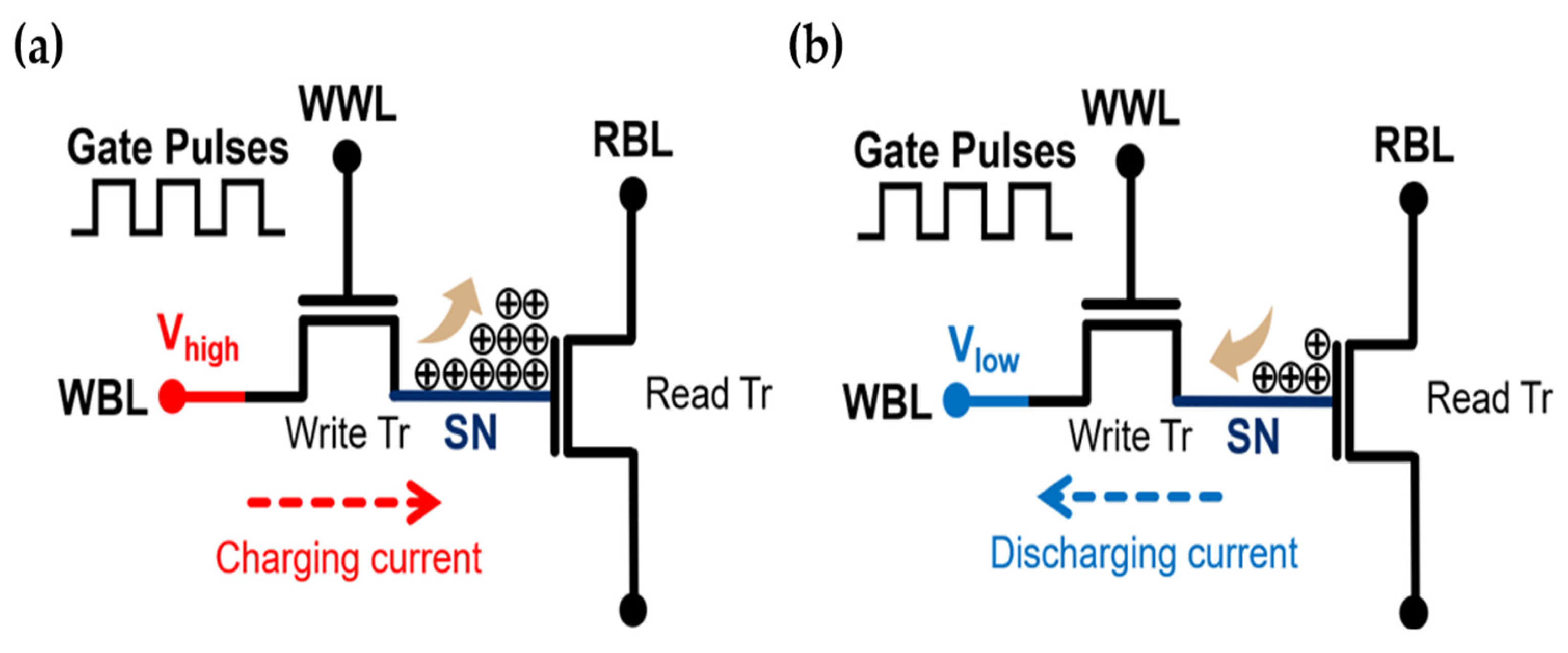

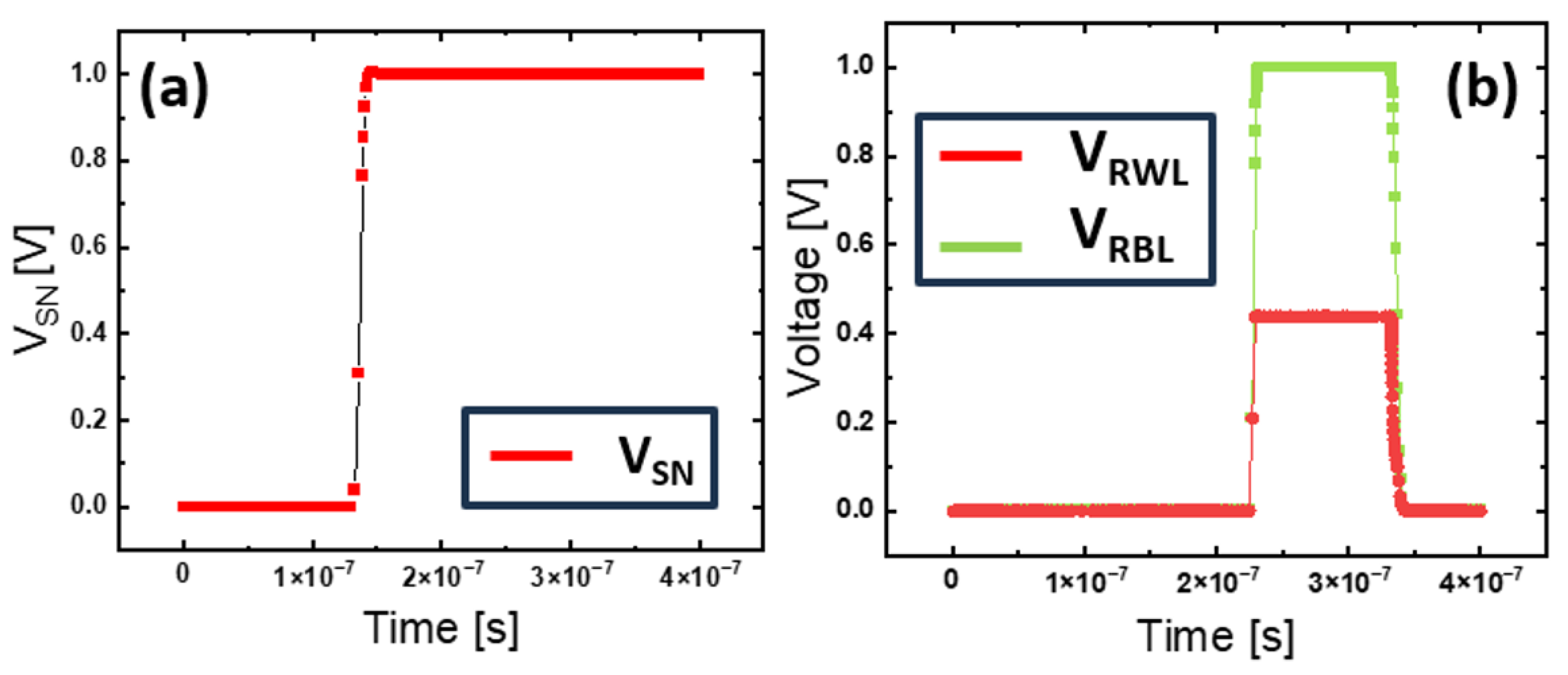
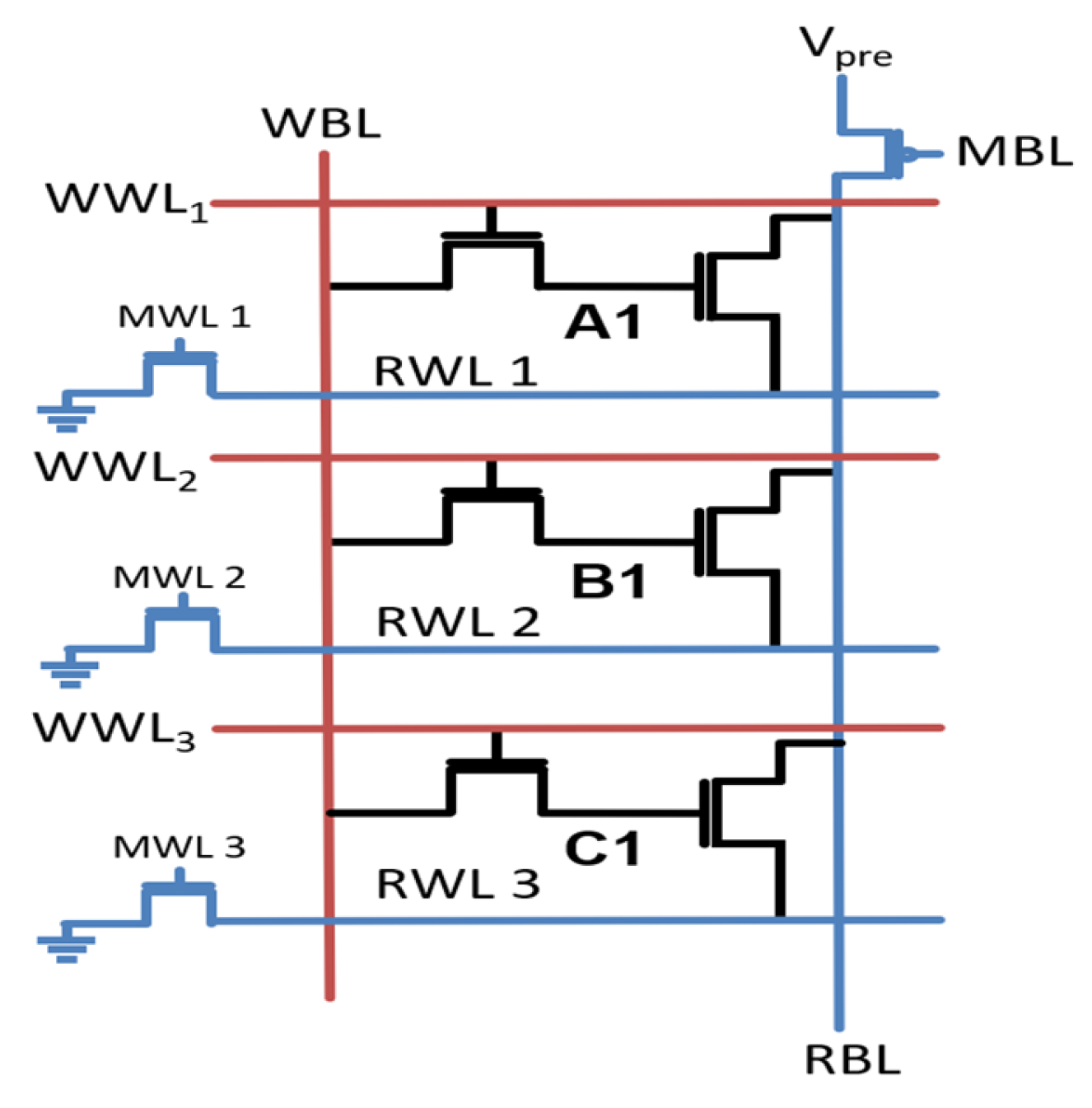

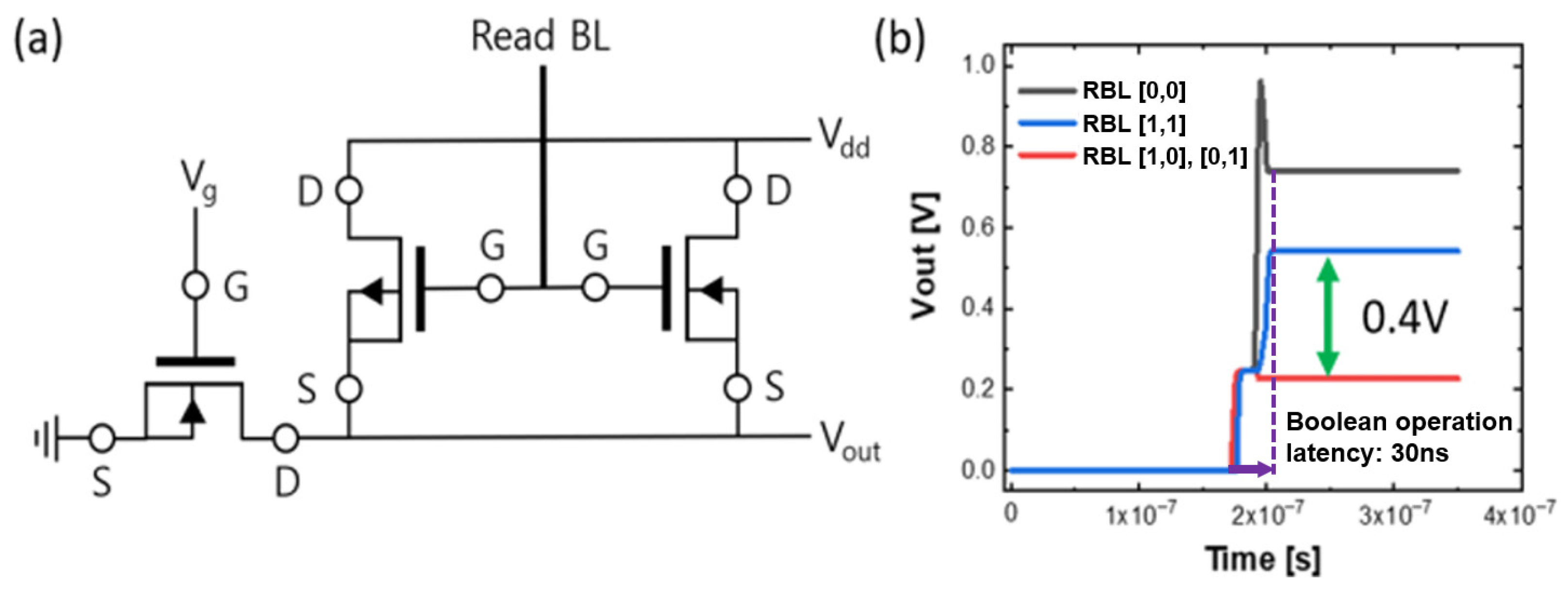

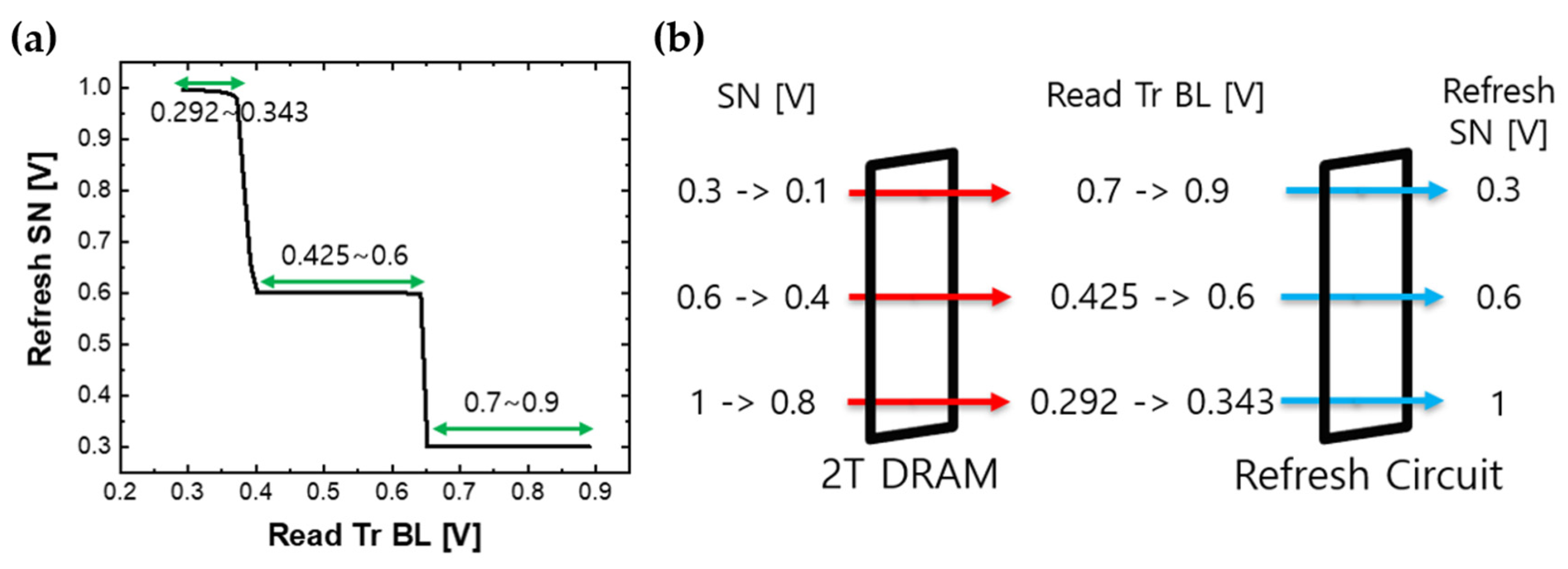
| SRAM | 2T-DRAM | 1T-DRAM | |
|---|---|---|---|
| Retention | While powered | >64 ms | Possibility of data loss after read |
| Cell size (F2) | 80–120 | <6 | <4 |
| Access speed | Ultra-Fast | Fast | Fast |
| Power consumption | High | Medium | Low |
| Parameter | Value | Parameter | Value |
|---|---|---|---|
| Channel length | 1 | Drain diffusion junction area | 0 |
| Channel width | 1 | Source diffusion junction area | 0 |
| Drain diffusion junction perimeter | 0 | Temperature | Room temperature |
| Source diffusion junction perimeter | 0 |
| Operation Condition | Logic Operation Results | ||||
|---|---|---|---|---|---|
| Logic operation | High: 1 V Low: Ground | [0,0] | [1,0] | [0,1] | [1,1] |
| OR | VMBL: High VMWL1: High VMWL2: High VMBL3~n: LOW | 1 V | 0 V | 0 V | 0 V |
| AND | VMBL: 0.2 V VMWL1: High VMWL2: High VMBL3~n: LOW | 1 V | 0.8 V | 0.8 V | 0.4 V |
| XOR | Vdd: High Vg: High | 0.8 V | 0.2 V | 0.2 V | 0.6 V |
Disclaimer/Publisher’s Note: The statements, opinions and data contained in all publications are solely those of the individual author(s) and contributor(s) and not of MDPI and/or the editor(s). MDPI and/or the editor(s) disclaim responsibility for any injury to people or property resulting from any ideas, methods, instructions or products referred to in the content. |
© 2025 by the authors. Licensee MDPI, Basel, Switzerland. This article is an open access article distributed under the terms and conditions of the Creative Commons Attribution (CC BY) license (https://creativecommons.org/licenses/by/4.0/).
Share and Cite
Kim, Y.-S.; Kwon, M.-W. Implementation of Boolean Logic Operations and Refresh Circuit for 2T DRAM-Based PIM Architecture. Electronics 2025, 14, 4483. https://doi.org/10.3390/electronics14224483
Kim Y-S, Kwon M-W. Implementation of Boolean Logic Operations and Refresh Circuit for 2T DRAM-Based PIM Architecture. Electronics. 2025; 14(22):4483. https://doi.org/10.3390/electronics14224483
Chicago/Turabian StyleKim, Yeon-Seok, and Min-Woo Kwon. 2025. "Implementation of Boolean Logic Operations and Refresh Circuit for 2T DRAM-Based PIM Architecture" Electronics 14, no. 22: 4483. https://doi.org/10.3390/electronics14224483
APA StyleKim, Y.-S., & Kwon, M.-W. (2025). Implementation of Boolean Logic Operations and Refresh Circuit for 2T DRAM-Based PIM Architecture. Electronics, 14(22), 4483. https://doi.org/10.3390/electronics14224483







